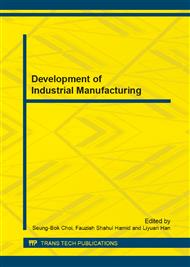p.552
p.556
p.564
p.568
p.573
p.583
p.588
p.593
p.598
The Influence of Alcohol Amine Admixtures on the Macroscopic Properties of Portland Cement Paste
Abstract:
It is studied the influence of triethanolamine (TEA), diethylenetriamine (DEA), Triisopropanolamine (TIPA), aminoethyl ethanolamine (AE), and polyvinyl alcohol ammonium phosphate (PAAP) at different dosages on the properties of fresh and hardened cement pastes and mortars prepared by Portland cement, including standard consistency water, setting time, the cement paste fluidity, and compressive and flexural strength. It is showed that the high polarity alcohol amine molecules exhibit strong chemical interactions with cement matrix, which are reflected in modified macroscopic properties of the cement system. All alcohol amine admixtures increased the standard consistency water and decreased cement paste fluidity of Portland cement. TEA significantly shortened the initial setting time and final setting time of Portland cement. On the other hand, TIPA, DEA, AE and PAAP extended the initial setting time of cement but shortened the cement final setting time. All alcohol amine admixtures except TIPA at 0.2 and 0.5 dosage increased the compressive and flexural strength of the Portland cement mortars at 3 days. Especially when the dosage of PAAP is 1, the compressive strength of the Portland cement mortars at 3 days is increased 10.5MPa. All alcohol amine admixtures except AE at 0.2 and 0.5 dosage increase the compressive and flexural strength of the Portland cement mortars at 28 days, Especially when the dosage of TIPA is 1, the compressive strength of the Portland cement mortars at 28 days is increased 8.8MPa.
Info:
Periodical:
Pages:
573-579
Citation:
Online since:
February 2014
Authors:
Price:
Сopyright:
© 2014 Trans Tech Publications Ltd. All Rights Reserved
Share:
Citation:


